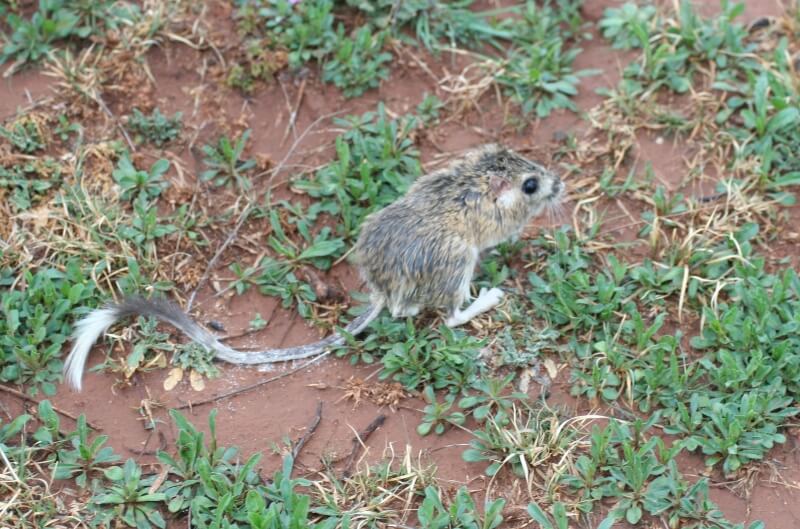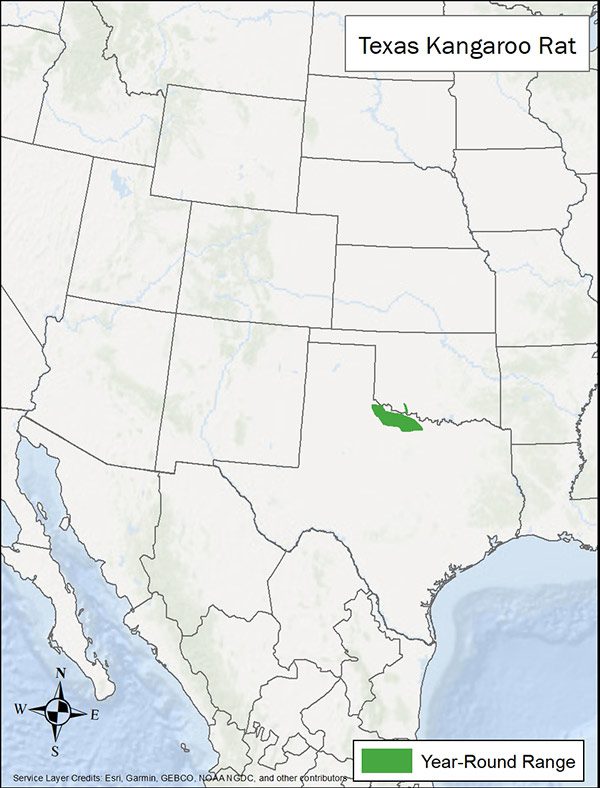LandPKS Learning
Habitat Hub

Texas Kangaroo Rat
Texas kangaroo rats rarely need to drink water. They’re highly adapted to arid environments where standing water is scarce and get moisture from vegetation. They also have cheek pouches which they use to gather grass seeds and store them in their underground burrows to survive drought.
Dipodomys elator
Identification
The Texas kangaroo rat is a relatively large rodent approximately 12.5 in/32 cm long, including a very long tail with a tuft of white hair at the tip. The coat is yellow-brown with interspersed black hairs and a white belly. They have characteristically large eyes, small ears, and very large back feet (almost 2 in/4.5 cm long). Their big feet, and ability to jump, gives them the kangaroo rat name. The Texas kangaroo rat is significantly larger than other species of kangaroo rats in its range. While the historical range included 11 counties in Texas and Oklahoma, they are now only found in 5 or 6 Texas counties and may no longer exist in Oklahoma. There are fewer than 100 known occurrences of Texas kangaroo rats, and fewer than 20 with good viability, and in 2011 was considered for a federal Endangered Species Act listing and found potentially warranted.
Observation Tips
Texas kangaroo rats are nocturnal and spend days in underground burrows. Trails that lead to their burrows may be visible. Peak activity are 2-3 hours after dark and they may not be active at all during a full moon. Burrows are often at the base of mesquite plants in areas with plenty of bare ground. They reproduce throughout the year, raising 2-4 young per litter in underground nests. Most known colonies of Texas kangaroo rats are on private land.
Interesting Fact
Texas kangaroo rats rarely need to drink water. They’re highly adapted to arid environments where standing water is scarce and get moisture from vegetation. They also have cheek pouches which they use to gather grass seeds and store them in their underground burrows to survive drought.
Ideal Habitat
Ideal habitat for the Texas kangaroo rat is open bare ground (30-80% cover) with areas of short, sparse grass (<55% cover). Typical habitat includes shortgrass prairie with bare ground and scattered, short woody shrubs, often mesquite (vegetation height <15.5 in/40 cm). These types of open, sparsely vegetated areas provide good visibility and soil for dust bathing. They are often found in heavily grazed or otherwise disrupted habitat with clay-loam, sandy-clay-loam, and sandy loam soils for burrowing.

Range map provided by International Union for Conservation of Nature
Management Activities that Benefit Species – Best Management Practices (BMPs)
Texas kangaroo rats are compatible with livestock grazing. Livestock grazing can improve habitat for kangaroo rats, when it maintains or expands areas of bare ground, shorter grasses, and fewer tall shrubs. Historically natural fires, bison, and prairie dogs also helped to create and maintain ideal kangaroo rat habitat, keeping grasses short for visibility. Mow, graze, or use other methods to remove tall, dense, overgrown vegetation from Texas kangaroo rat habitat. Introduce small, frequent fires in Texas kangaroo rat habitat to help maintain enough bare ground and short vegetation. Also, consider allowing black-tailed prairie dogs to remain or expand onto portions of your private property.
Management Activities to Avoid
Avoid habitat loss and fragmentation from conversion to agriculture and residential development. Avoid introducing non-native grasses, which can take over native habitat, dominating the area and obscure visibility. Avoid fire suppression activities. Avoid eliminating other species that can create and maintain suitable Texas kangaroo rat habitat, including black-tailed prairie dogs.
Other Species that Benefit from Similar Habitat Management
Texas kangaroo rats are an important prey species for snakes, coyotes, and badgers. They may also contribute to native grass growth through seed dispersal when seeds stored in underground burrows are left uneaten.
Download
Download the Texas Kangaroo Rat Factsheet
Other Resources
International Union for Conservation of Nature (IUCN). 2016. The IUCN Red List of Threatened Species. Version 2021-1. Texas kangaroo rat.
NatureServe. 2021. NatureServe Explorer: An online encyclopedia of life [web application]. Version 7.1. NatureServe, Arlington, Virginia. Dipodomys elator.
US Fish and Wildlife Service (FWS). 2016. Texas kangaroo rat.
Mobile App | Data Portal | Knowledge Hub | Habitat Hub | Learning Collections | Blog | About | Contact | Support



